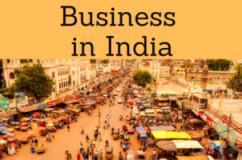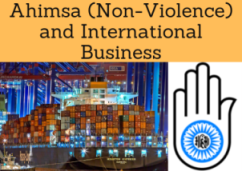Hindu Economic Area (Indian Civilization)

Regional Integration, Hindu Civilization (India, Nepal) Hinduism

The subject “Hindu Economic Area” consists of seven parts:
- Introduction to the Indian religions and its relationship with the Hindu Civilization
- Hinduism
- Islam in India (Bharat)
- Sikhism, Jainism, and Zoroastrianism
- Hindu Economic Area
- India as the Central State of the Hindu Civilization
- Countries in the area of influence of the Hindu Civilization: Mauritius, Nepal, and Bhutan
- Hindu Businesspeople
- Economic Integration of the Hindu Civilization (institutions, trade agreements)
- Interactions of the Hindu Civilization with the other civilizations
- Economic Organizations and Trade Agreements related to the Hindu Civilization
- Diaspora of the Hindu Civilization
The objectives of the subject “Hindu Economic Area” are the following:
- To define the characteristics of the Economic Area of the Hindu Civilization
- To analyze the influence of the Indian religions on the Hindu Economic Area
- To know the economic profile of the Hindu Countries
- To analyze the Businessmen profile of the Hindu Civilization
- To understand the economic integration process of the Hindu Civilization
- To know the economic relationships of the Hindu Civilization with the other civilizations (Western, Sinic, Buddhist, Islamic, Orthodox, African)
- To analyze the main Economic Organizations related to the Hindu Economic Area

The Subject “Hindu Economic Area” belongs to the following Online Programs taught by EENI Global Business School:
Course: Indian Religions and Business.
Bhagavad Gita Courses: Karma Yoga, Bhakti Yoga, Jnana Yoga, Dhyana Yoga, Realization of the Gita
Doctorate: Ethics, Religions & Business, World Trade.
Masters: International Business, Foreign Trade, Religions & Business.
Languages:  or
or  Civilización Hindú
Civilización Hindú  Civilization Hindou
Civilization Hindou  Civilização Buddhist.
Civilização Buddhist.
Why study “Indian Religions and Business”?.
- Credits of the Subject “Hindu Economic Area”: 2

- Duration: two weeks
- Download the syllabus “Hindu Economic Area” (PDF)

 Masters adapted to Indian Students (Bharat).
Masters adapted to Indian Students (Bharat).
Related Subjects to the “Hindu Economic Area”
1- Introduction to the Indian religions and its relationship with the Hindu Economic Area.
- Hinduism
- Zoroastrianism
- Jainism
- Sikhism
- Islam in India (Bharat)
2- The Hindu Economic Area and the economic profile of the countries of the Hindu Civilization
- Introduction to the Hindu Economic Area
- India as the Central State of the Hindu Civilization
- Republic of India
- Economic Profile of Andhra Pradesh, Gujarat, Haryana, Karnataka, Kerala, Maharashtra, New Delhi, and Tamil Nadu
- Countries in the area of influence of the Hindu Civilization
- Mauritius: a strategic place for business between Africa and India. 54% of the Mauritian population is Hindu
- Nepal: 81% of the Nepalese population is Hindu (23 million of Nepalese)
- Bhutan. 25% of the population of Bhutan is Hindu
- The Indonesian island of Bali has a Hindu majority (93%, 4.2 million Indonesians). However, this analysis does not include Indonesia (included in the Islamic Civilization)
3- Businesspeople of the Hindu Civilization.
- Hindu Businesspeople: Senapathy Gopalakrishnan, Srichand Hinduja, Kumar Birla, Kiran Mazumdar, Shri Mukesh D. Ambani
- Muslim Businesspeople: Azim Premji, Yusuf Hamied
- Zoroastrian Businesspeople: TATA, Cyrus S. Poonawalla, Adi Godrej, Nusli Wadia
- Jain Businesspeople: Sahu Jain, Bhavarlal Jain, Ajit Gulabchand, Gautam Adani
- Sikhs Businesspeople: Jogishwar Singh, Shivinder Singh, Ajaypal Singh Banga
- Kenyan Businesspeople of Indian origin: Naushad N. Merali and Bhimji Depar Shah
4- Economic Integration of the Hindu Civilization (Economic Organizations, Trade Agreements)

- India-Mauritius Agreement
- India-Bhutan Trade Agreement (commerce and transit)
- India-Nepal Trade Agreement
- Bhutan, India, and Nepal are members of
- South Asian Association for Regional Cooperation (with Afghanistan, Bangladesh, the Maldives, Pakistan, and Sri Lanka. Mauritius is an observer of the SAARC)
- Bay of Bengal Initiative (with Myanmar, Bangladesh, Sri Lanka, and Thailand)
- Asian Clearing Union (with Bangladesh, Iran, Myanmar, the Maldives, Pakistan, and Sri Lanka)
- South Asia Economic Cooperation (SASEC) (with Bangladesh, the Maldives, and Sri Lanka)
- Mauritius and India are members of the Indian-Ocean Rim Association (with eighteen countries)
5- Interactions of the Hindu Civilization with the other civilizations.
- With the Buddhist Civilization
- India has Trade Agreements with Sri Lanka, Thailand, Singapore, and South Korea
- With the Western Civilization
- With the European Economic Area:
- With the American Economic Area:
- North American
- Mauritius and the U.S.: AGOA, COMESA-U.S. Agreement, Trade Agreement Mauritius-United States
- India-Canada Agreement
- Latin American. Hindu Civilization has trade agreements with Chile, MERCOSUR, and the Andean Community
- The Caribbean. No Hindu country has Trade Agreements with the Caribbean Countries
- North American
- With the area of Oceania: India has a Trade Agreement with New Zealand and Australia
- With the African Civilization
- The Preferential Trade Agreement between India and the SACU (South Africa, Lesotho, Eswatini, Botswana, and Namibia)
- Mauritius is a member of:
- Africa-India Cooperation
- Asia-Africa Corridor
- Africa-BRICS Countries Cooperation
- All the countries of the Hindu Civilization are members of the Africa-Asia Strategic Partnership
- With the Muslim Civilization:
- India has Trade Agreements with Indonesia, the Gulf Cooperation Council (GCC), the Maldives, Bangladesh, Afghanistan, and Pakistan
- Nepal has an agreement with Bangladesh
- Bhutan has a Trade Agreement with Bangladesh
- Mauritius has a trade agreement with Turkey and a Preferential Trade Area with Pakistan
- India-Afghanistan Corridor
- Corridor of the Ashgabat Agreement
- Agreements between civilizations
- Asia-Pacific Trade Agreement (with Bangladesh, China, South Korea, Laos, Sri Lanka, and Mongolia)
- Agreement between the ASEAN and India
- Bangladesh-Myanmar Corridor
- North-South Corridor (India-Russia)
* This subject presented only major FTA related to the Hindu Civilization.
6- Diaspora of the Hindu Civilization.
- Hindu Diaspora
- Sikh Diaspora
- Zoroastrian Diaspora
- Jain Diaspora
7- Economic Organizations related to the Hindu Civilization.
- ESCAP
- Asian Development Bank
- Asia-Europe Meeting
- Asia-Middle East Dialogue
- Colombo Plan
- Asia Cooperation Dialogue
- Boao Forum for Asia
- African Union
- African Development Bank
- AUDA-NEPAD
- Economic Commission for Africa
- NU
- IMF
- WTO
India, a continent by itself, is logically the Central State of the Hindu Civilization. India is also a BRICS Country and the largest democracy in the World (1,210 million people).
The Hindu Civilization has a vital strategic location bordering several civilizations: Islamic, Buddhist, Sinic, and the African Civilization (thanks to Mauritius).
To define the Hindu Civilization, we will consider two factors: religious and historical. The current Hindu Civilization can be regarded as the subsidiary of the ancient Indian (Indo) civilization (almost 3,000 years old).
Religions that defines the Hindu Civilization.
India is the cradle of four religions: Sikhism, Jainism, Hinduism, and Buddhism, sharing many values such as Ahimsa (Non-Violence), respect for the animals and respect for the other religions. All these faiths define the Hindu Civilization.


It is also necessary to consider the importance of Islam and Christianity in India.
Hinduism.
Approximately 960 million of the Indian people follow Hinduism (80% of the Indian Population), making it the third religion in the World by the number of believers (behind Christianity and Islam, and ahead of Buddhism and Sikhism). Hinduism is the main religion in twenty-seven States of India.

Islam in India.
About 13% of the Indian Population is Muslim (172 million of Indian Muslims) and is, therefore, the second religion in India by the number of followers. There are Muslim majorities in Lakshadweep, Jammu and Kashmir and is also vital in Uttar Pradesh, West Bengal, and Bihar. Almost all Indians are Barelvi (Sunni Hanafi school). The Indian Muslims control big business like Wipro or CIPLA laboratories.
When India gained the independence from the British Empire, lost two important regions: Pakistan and Bangladesh, which joined the Islamic Civilization.
Christianity in India.
2% of the Indian Population is Christian (24 million people).
Sikhism

Sikhism represents 1.9% of the Indian Population, especially in Punjab. The recognized moral rectitude of the Sikhs promotes the access to relevant executive positions worldwide (Rothchild or Mastercard). Many Hindus recognise to Sikhism as the “armed wing” of Hinduism. Approximately, there are twenty-six million Sikhs worldwide.
Zoroastrianism

Although was originally from Persia (Iran), Parsees have played a major role in the Hindu Civilization. Zoroastrians are a vital business community in India, the TATA group or the Businessman Cyrus Poonawalla are Zoroastrian.
Buddhism
Although Buddhism was born in India, today just 0.77% of the Indian Population practices Buddhism. However, it is necessary to note that for many Indian, Buddhism is part of Hinduism and recognizes Buddha as a divine incarnation.
Jainism

Jainism is just barely practiced by 0.41% of the Indian population (between 5 and 6 million of Jains in India). Despite being a slight community, influential businesspeople are Jain, such as Indu Jain who controls the newsgroup Times and Bennett, Coleman Co.
Diaspora of the Hindu Civilization.
It is necessary to consider the Hindu Diaspora because they are important players in the business community in many countries.
Furthermore, the following countries, where Hindus often have excellent business relations, must be taken into account:
- There are some countries where Hinduism is the second religion: Fiji (28% of the population, 3.9 million people), Guyana (23%), Suriname (20%), Trinidad and Tobago (18%), Sri Lanka (15%), Pakistan (1%, 3.6 million), and Bangladesh (9%, some 15 million Bangladeshis are Hindus)
- In Singapore, 6% of the population is Hindu
- Influence of the Hindu population in East Africa, especially in Kenya (1% of the population), Tanzania, and Uganda. However, these countries belong to the African Civilization
- The following countries have small Hindu communities: Australia (2%), Saudi Arabia (1%), Burma (1.5%), the U.S. (0.5%), Canada (1.6%), Qatar (7%), the Seychelles (2%), Reunion (7%) Malaysia (6%), Bahrain (6%), Kuwait (12%), the UK (2%), South Africa (2%), the UAE (11%), Belize (2%), Oman (4%), New Zealand (2%), and the Philippines (1%)
The Sikh Diaspora is important in Canada (1.4% of the population), the UK (0.8%) and the U.S. (0.08).
The Zoroastrian Diaspora is found mainly in Pakistan.
They are Jain small communities in Belgium, Canada, Hong Kong, Japan, Singapore, and the U.S..
Sample:
(c) EENI Global Business School (1995-2024)
We do not use cookies
Top of this page




